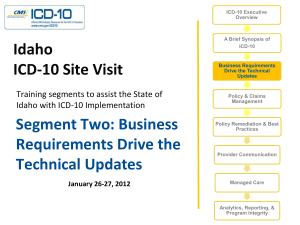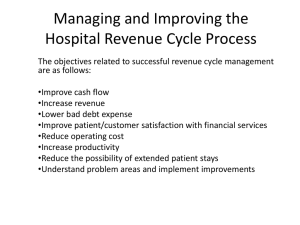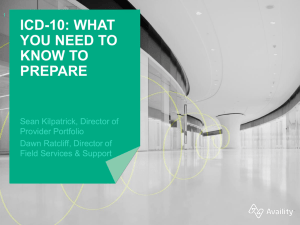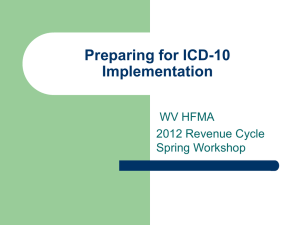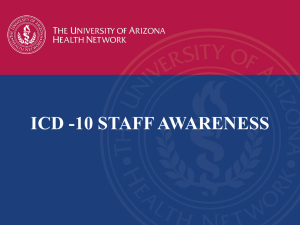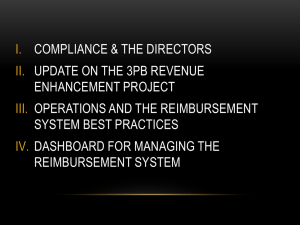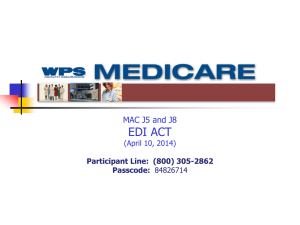January 2015 - dignityhealthmember.org
advertisement
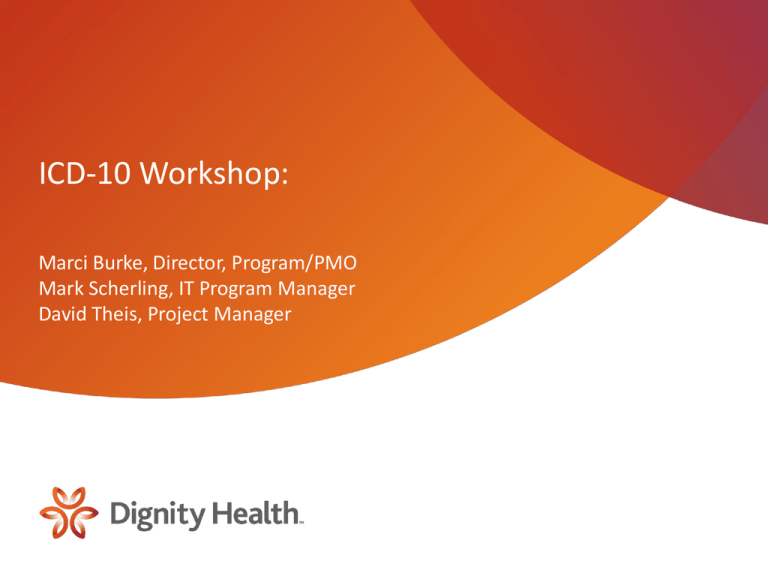
ICD-10 Workshop: Marci Burke, Director, Program/PMO Mark Scherling, IT Program Manager David Theis, Project Manager Reflection: The Storm is Coming 2 Preparing for the Storm • Have an Emergency Plan • Practice the Plan • Listen for Warnings • Recognize the Signs • Take the Threat Seriously 3 Agenda • ICD-10 Overview • Provider Readiness & Workshop • Non-Provider and Ancillary Staff Readiness • System, Report, and Form Remediation • Readiness Plans for Key Roles and Other Entities • Next Steps 4 ICD-10 Overview 5 ICD-10 Leadership Executive Program Sponsor Tim Panks Program Advisors Katie LeBlanc Shelly Walters IT Sponsor Stan Martin Clinical Sponsor Dr. Joseph Colorafi Program Director Marci Burke Optum 360 Sponsor Emily Rafferty ICD-10 PMO Marci Burke Jonathan Weeks Tawnya Infantino HIM / Coding Chair Brian Dessoy Provider / Clinical Chair Dr. Chandrasena IT Lead Nataiya Waller IT Lead Kevin Barbee-Acute Mark Scherling-Amb Revenue Cycle Chair Jennifer Igel (Acute) Steve Scharmann (Amb) IT Lead Nataiya Waller-Acute Mark Scherling-Amb PM MJ Murphy Gonzalez PM MJ Murphy Gonzalez PM Chris Cruise Organizational Readiness PM, David Theis Home Health Chair Paul Giles IT Lead Mark Scherling PM Chris Cruise 6 **blue text = Optum360 employee What Changes from ICD-9 to ICD-10? The magnitude of ICD-10 vs. ICD-9 code sets is significant ICD-10 code sets: • Represent an 800% increase over ICD-9 code sets • Will be alphanumeric in nature and include an alphabetic lead character • Logical; organized by core concepts Structural changes will provide specificity and clinical detail capturing advances in medical technology Changes to code sets include: • Inclusion of a character to indicate laterality • More clarity around severity of illness or injury, as well as, an initial or secondary occurrence 7 Why does Dignity Health care about ICD-10? Coder Productivity Challenges Additional Specificity in Physician Documentation Increase in Initial (temporary) Denial Rate Increase in AR Days Payer Readiness & Compliance 8 ICD-10 Strategies for Key Roles Providers Non-Provider & Ancillary Clinical Clinical Documentation Specialist Coders Patient Financial Services Patient Access (Registration) Strategy Goals: • Implement education to ensure critical roles prepared to comply • Identify strategies that minimize productivity impacts • Prepare systems to support transition and minimize impact 9 Who has assisted with strategy and validated our work? Optum 3M Deloitte Ernst &Young CHAN 10 ICD-10 Delay 11 ICD-10 Delay Response New Deadline: October 1, 2015 Key Considerations 11 Billion exposure if we are not ready Mitigation Strategies Shift majority of work “just in time” to minimize risk of future delays Focus on work that benefits Dignity Health today Provided opportunity to look at processes and make improvements Additional technology: Cerner and CAC 12 Benefits of the Delay • Technology – 26 Facilities live on Cerner EHR – Computer Assisted Coding (CAC) for 23 Acute Facilities & Ambulatory – Additional upgrades and features to existing applications • Improved Plan – Streamlined Activities – Shifting more activity to centrally-led team 13 Pre-Delay Committee Structure • Historical Structure: – Facility Liaison (HIM Director) oversaw committees for: • HIM/Coding, Patient Access, Patient Financial Services, Clinical, Quality – Central ICD-10 PMs provided support to HIM Director & committees • Challenges: – Complex project plan – Duplication of effort with Optum360 transformation – Overlap of centrally-led activities 14 New Structure • New Structure: – Centrally-led ICD-10 Provider/Clinical Group: • Clinical and Quality – Dignity Health and Optum360 management is leading: • HIM/Coding, Patient Access, Patient Financial Services • Benefits: – Centralizing process and job aid development – Leadership and roll-out from Optum360 15 Roles and Responsibilities Centralized Program Local Sites • Creation & Facilitation of Education • Joint Venture & Vendor survey, assessment and remediation • Business testing & Payer readiness assessments • Advise Managed Care Contract Team • Create strategies, workflows and job aids and review with centralized teams • Provide job aid training • Advise Optum360 and Ambulatory leadership to identify and onboard contractors • Assessment and remediation for Corporate-supported applications, reports, and forms • Encourage education participation & provide logistics support • Develop MEC Resolution • Review/Follow-up on at-risk business vendors (as requested) • Job aid training participation • Operations and logistics support for on-boarded contractors • Assessment and remediation for all other* applications, reports and forms * Other will be defined in future slides. 16 Our Accomplishments • Assessed over 150 applications and hundreds of instances; Upgraded 54 applications (multiple instances) at 39 hospitals and over 125 clinics; Remediated 84% of in-scope application reports • Developed & implemented education plans for 40,000 learners • Identified productivity impacts, resources, and mitigation • Created and are implementing remediation strategies for: Managed Care Contracting Business Vendors Joint Ventures Practice Coding Business Testing Payer Contingency Cutover / Dual Processing Technology Remediation 17 Workshop Goals • Identify how local sites can increase provider engagement • Clarify scope for systems, reports, and forms remediation • Review readiness plans for impacted staff, vendors, and payers • Identify any gaps in our strategies • Work together to prepare for transition 18 Providers ICD-10 Readiness 19 Provider Impact • Problem/Opportunity: – ICD-10 requires increased specificity in documentation – Lack of specificity will result in increased queries • Anticipated Impact: 10-20% short-term productivity loss* • Solution: – ICD-10 Education – Clinical Documentation Education – Technology (available over time) * Helping Physicians Succeed (Alex et al., 2011) 20 Impacts Of Changing From ICD-9 To ICD-10 Additional documentation specificity may result in: • Appropriate payment: accurate payment for new and complex procedures, fewer rejected claims and better claims adjudication • More detailed physician profile: detailed representation of the complexity and quality of care provided, which will affect pay-forperformance programs (e.g., value-based purchasing) and risk-adjustment methodologies (e.g., mortality rates) • Research opportunities: more detailed information will enable data mining and create research opportunities which will benefit public health 21 Addressing Physician Engagement Physician Champion Network • Membership: 50 Physician Champions –Includes Acute and Ambulatory • Roles/responsibilities: –Foster engagement & peer-to-peer communication Leadership Education Oversight –Reviewing education strategy & curriculum –Coordinating training for providers CDI Engagement –Engaging providers in CDI program Communication 22 Clinical Documentation Improvement Centralized ICD-10 Program-Provided Education for Providers • CDI Training for employed and non-employed physicians, nurse practitioners, physician assistants, residents and fellows: – Acute In-Person: October–February 2015 – Acute and Ambulatory WebEx: February 2015 – Ambulatory In-Person: “Documenting Patient Acuity” (HCC) January-March 2015 at select locations • HCC’s associated with Medicare Part C, Capitated contracted – managed HMOs. Clinical Documentation Improvement is beneficial now, regardless of when ICD-10 is implemented. 23 Education for Providers: CDI Videos Centralized ICD-10 Program-Provided • CDI Videos for CME credit – 5 to 8 minute videos – ICD-9 and ICD-10 relevant documentation guidelines on severity and acuity – Marketed by CMOs, VPMAs, and ICD-10 Physician Champions General Documentation Guidelines Acute Blood Loss Anemia Acute Kidney Injury Acute Myocardial Infarction Congestive Heart Failure Cerebral Edema and Brain Compression Deep Venous Thrombosis and Pulmonary Embolism Excisional Debridement Hypo/ Hypernatremia Malnutrition/ BMI Pathology Findings Pneumonia Pressure Ulcers Sepsis 24 ICD-10 Education for Providers Centralized ICD-10 Program-Provided • ICD-10 Education for employed and non-employed physicians, nurse practitioners, physician assistants, residents and fellows: – eLearning: May – September 2015 – In-Person ICD-10 Training: July – September 2015 Education is offered just-in-time to ensure retention prior to ICD-10 implementation. 25 Documentation Assessment Centralized ICD-10 Program-Provided • Clinical Documentation Improvement – Physicians identified via analytics and local leadership – Assessment by Optum360 CDI consulting staff – Physician-specific and specialty specific results shared with physicians and each facility Clinical Documentation Improvement benefits us today and in an ICD-10 world 26 Community Physician Outreach Centralized ICD-10 Program-Provided • Training and Tools for Community Physicians – Outreach with Market Development Representatives begins January 2015 – 1 hour WebEx presentation and 5-page Guide • Topics: – Overview of ICD-10 – Financial Planning – Education for Physicians and their Staff – System, Report, and Form Readiness – Payer and vendor Readiness 27 Job Aid for Providers: ICD-10 Virtual Codebook Centralized ICD-10 Program-Provided • Available May 2015 • Easy to use • Search by code or clinical terms • Speech Recognition • Documentation Tips • Favorites • Internet access not required • Available on Apple or Android 28 ICD-10 Virtual Codebook Search Functions 29 ICD-10 Virtual Codebook Results 30 Physician Engagement The challenge of engaging physicians in ICD-10 31 Competing priorities • Today physicians are faced with countless demands on their time, so it is easy for ICD-10 to be pushed to the bottom on the agenda. • Two additional items also create complications: – Medicare and Stark Regulations – Competing ICD-10 Training 32 Regulations Prevent Physician Compensation for Training • Medicare anti-kickback regulations and Stark self-referral regulations prevent Dignity Health from providing monetary compensation to physicians that may have a referral relationship with Dignity Health. • Regulations permit Dignity Health to provide compliance programs to health care providers provided that programs are not offered based on volume or value of referrals or other business generated by referring physician. 33 Competing ICD-10 Training Offerings Site Led - Physician Education Reciprocity • Many physicians will be asked to participate in ICD-10 Training from different medical systems: – VPMAs and Medical Staff Leadership are in charge of working with physicians at their facilities to determine specifics on reciprocity training agreement. • ICD-10 Program provided a template to ICD-10 Physician Champions. • Reciprocity is based on MEC guidelines per facility. – ICD-10 Program recommends and encourages all physicians take the Dignity Health ICD-10 training. 34 Workshop Questions 1. How do local sites encourage provider participation? – CDI Videos – ICD-10 in-person training – ICD-10 eLearning 2. Who should Centralized ICD-10 Communications work with at your local site? 35 Providers: ICD-10 Roles and Responsibilities Centralized Program • Education opportunity selection and funding • Facilitation of education rollout including document assessment & ICD-10 Virtual Codebook • Send out master communication Local Sites • Ensure participation in Education and Documentation Assessment • MEC Resolution* • Logistics Support (for inperson training) * ICD-10 Program provided a recommended template for the MEC resolution; however, passage of resolution is facility specific. 36 System, Report and Form Remediation ICD-10 Readiness Corporate and Local Scope 37 System, Report and Form Impact • Problem/Opportunity: – ICD-10 requires updates to applications, reports, and forms that contain ICD-9 codes – Need to address the “gap” between what the centralized ICD-10 Team is remediating and the remediation needed at each local site • Solution for Addressing the “gap”: – CFO, ICD-10 Facility Executive Champion, identifies a local leader at each facility to lead the remaining effort. Role includes: – – – – Bring together departmental leadership Drive day-to-day site committee activity Escalate issues/risks to site leadership Manage and communicate project status to site leadership 38 Partnering for Success ICD-10 Executive Champion (Site CFO) Optum360 Leadership (Acute Only) CFO-Selected Committee Chair Local Site Application Expert or Vendor Site Leadership (includes IT Site Directors and CIO) 39 What systems, reports or forms need ICD-10 remediation? • Any system (application), database, interface, registry, or bolton that includes ICD-9 diagnosis or procedure codes • Any report that includes ICD-9 diagnosis or procedure codes • Any form that includes ICD-9 diagnosis or procedure codes 40 Remediation Overview Generally, remediation includes: • Implementing any patches or upgrades for ICD-10 from vendor • For custom software, reports or forms: – Expanding ICD-9 fields to allow for alphanumeric with 3-7 characters, with an alphabetic lead character; Decimal after the 3rd character – Potentially mapping ICD-9 codes to new ICD-10 codes within report selection statements – Updating report filters if necessary • Testing/Validation of anything adjusted for ICD-10 • Ensuring ICD-10 changes are in place prior to October 1, 2015 41 Scope Definition: ICD-10 Program or Local Site 42 Methodology to Identify ICD-10 Program Scope Phase 1: First draft of Impacted Applications List (IAL) finalized. • Corporate-supported systems data collected by 5010 team; initial impact assessment began • Interviews conducted with support teams/vendors/local sites to add to the 5010 listing • Priorities assigned based on ICD-9 availability and usage as outlined by business partners • Additional interviews with support teams and managers to verify information 43 Methodology to Identify ICD-10 Program Scope Phase 2: 2nd Assessment due to ICD-10 Implementation Date Delay, Impacted Applications List (IAL) Updated • Validated IAL through additional assessments and interviews with support teams, business partners and local sites • Consolidation explored if deployed at more than 1 facility • IAL reviewed to identify applications previously documented as decommissioned or ready for archive • Reviewed applications slated for decommission due to EHR, Optum360 or other implementations (these were removed from scope) Continued Assessments: The centralized ICD-10 Program has governance process for assessing and approving scope changes • Applications slated for decommission or replacement due to EHR, Optum360, Ambulatory or other implementations • New scope as a result of new software implementations or acquisitions of new clinics prior to the July 1, 2015 cutoff date 44 Example of Impacted Applications List (IAL) 45 Application Remediation Overview Centralized ICD-10 Program Team remediation includes: Home-grown reporting databases - Corporate-supported applications with ICD-10 impacts and functionality usage confirmed by the ICD-10 Team - Systems not being decommissioned or replaced by another system prior to July 1, 2015 Customized Software or Systems Centralized ICD-10 Program Remediation is on-track. Local Site remediation is required for: Screen Scraping Technology - Locally supported applications, databases, interfaces, registries, screen-scrape technology, bolt-ons or customized software with ICD-9 codes which are not listed in the IAL (i.e. not managed by corporate IT) - Work with your vendor or local expert to remediate - Leverage list of ICD-10 applications that your site identified previously located in your packet Locally managed application remediation efforts are anticipated to be small and low risk. If you need help with a specific system (application) not listed within the ICD-10 IAL, send an email to the ICD-10 Program Team at: ICD-10@DignityHealth.org Outsource Vendors Applications producing files to 3rd parties 46 Reports Remediation Overview Centralized ICD-10 Program Team remediation includes: • Vendor-supplied standard reports in the ICD-10 Program IAL • Reference your packet for reports which are not standard, but have been assessed by the ICD-10 Program Team and have potential to be in scope Quality reports (QA) Admissions census reports Clinical registry reports Local Site remediation is required for: • Customer defined (custom) reports that include ICD-9 diagnosis or procedure codes (which are not listed in the ICD-10 report remediation list in your packet) • Queries within corporate-supported systems listed in the IAL that include ICD-9 diagnosis or procedure codes • All reports in locally supported applications, databases, or registries that include ICD-9 diagnosis or procedure codes – Work with your vendor or local expert to remediate these reports. These may be managed by Local IT or Application Experts in the Department. Vendor reports Daily reports with diagnosis Discharge planning reports Risk Management Need help with a specific report not listed within the ICD-10 Program-remediated reports list? 47 Reports Remediation Help Option 1: Work with your ICD-10 IT Project Manager to better understand what ICD-10 is remediating to identify gaps and determine your next steps. Option 2: Open a Help Desk Ticket The ICD-10 Program will assess whether or not ICD-10 or Corporate IT will be able to accommodate the request. IMPORTANT: We recommend all requests be submitted as soon as possible, but no later than March 1, 2015. Start your assessments now. How to open a ticket: Effective February, you may call the help desk to open a ticket. The ability to open a ticket via the help desk web portal will be available in early February. Further communication to follow when this method is available. There is quite a bit of information you will need to have on hand when opening a help desk ticket…. 48 Opening a Report Remediation HD Ticket - Required Requestor Name Facility Name Phone Number Service Area Email Address Department Report Specifics • Application Name • Report Name • Report Type (Standard, Custom, Ad-hoc, User created) • Report Distribution Method (Email, Web, File Share) • Frequency of use (How often the report is ran – daily, weekly, bi-weekly etc.) • Report Description (Description that explains the purpose of the report, audience and risk of not remediating for ICD-10) • Will ICD-9 to ICD-10 code mapping be needed to complete remediation of this report? Yes or No • Does the report include ICD-9 Diagnosis or Procedure Codes? Yes or No • Attach additional supporting information (Ex. Report filters, criteria, output etc.) • Additional Comments 49 Forms Remediation Overview Centralized ICD-10 Program Team remediation includes: None ABN forms Local Site remediation is required for: – Paper Forms: Update Paper Forms that include ICD-9 diagnosis or procedure codes via your vendor or Microsoft Word. • Paper forms cannot be submitted to local IT or corporate IT for remediation. – Electronic Forms: Update Electronic Forms that include ICD-9 diagnosis or procedure codes via FormFast or similar software. • FormFast form update requests should be submitted directly to vendor. IT does not support FormFast forms outside of EHR armbands and labels. – Optum360 is centrally remediating PFS, PAS and HIM forms. – Forms Committees or Clinic Directors should identify and update any forms that include ICD-9 diagnosis or procedure codes – Third Parties remediate their own forms. Your packet includes a 1page instruction sheet on form remediation to return to third parties. Medicare forms Hospital Face Sheet Charge tickets/Encounter forms/Super Bills Referral forms Order forms – Lab, Diagnostic Imaging, Physical Therapy Physician orders (Admission orders) 50 ICD-9 to ICD-10 Mapping Assistance Identify Identify any ICD-9 codes that need to be translated to ICD-10 in systems, forms, or reports Submit Submit mapping request form no later than May 1st to: ICD-10@DignityHealth.org Map Remediate ICD-10 Program maps ICD-9 codes to ICD-10 codes, and returns to requestor Local Site remediates the systems, forms, or reports using the ICD-10 mapping Depending on volume and site capability the program may also provide a license to the software and train the users on the tool. 51 ICD-10 Local Remediation – Suggested Timeline ICD-10 Go Live | October 1, 2015 February January - ICD-10 Workshop - Identify Facility Lead - Establish meeting cadence and responsibilities March – June - Finalize identification of ICD-10 non-assessed locally supported systems, reports or forms - Update identified systems, reports and forms - Identify remediation resources - Request mapping assistance by May 1st. - Request mapping assistance if needed - ICD-10 Program Check Point (March) July-September - Test systems, validate reports, obtain form approval - Plan to put in place for October 1, 2015 -Plan for October 1, 2015 go-live support 52 Reference Information: Provided after Workshop Systems (Applications) • Impacted Application List (IAL): List of corporate-supported systems which will be remediated by the centralized ICD-10 Program IT Team. Includes assessment results. • List of ICD-10 impacted systems that your site identified previously Reports • List of reports from larger corporate systems which have been assessed for remediation by the ICD-10 Program Forms • ICD-9 to ICD-10 Mapping request form • 1 page instruction sheet on form remediation to return to third parties Tools • Tracking tools to use to manage your application, forms and report remediation • List of Questions for IT Vendors and Application Subject Matter Experts 53 Reference Information Examples 54 Roles and Responsibilities – Systems, Reports and Forms Centralized Program Local Sites • Assessment and remediation for • corporate-supported applications on the Impacted Applications List (IAL) • reports for Corporatesupported applications on the Impacted Applications List (IAL) – standard reports only • Assessment and remediation for • local applications not supported by Corporate (not on IAL) • reports not supported by Corporate (not on IAL) – nonstandard or custom reports or queries • All electronic or paper forms • PFS, PAS, and HIM acute forms will be centrally remediated by Optum360 55 Our Ask of You 1. Establish leadership at the local site to drive work which is out-of-scope for the centralized ICD-10 Program 2. Identify “gray areas” and contact ICD-10@DignityHealth.org • If you have questions regarding a system (application) not on the IAL (Impacted Applications List) • To submit request form for ICD-10 mapping assistance by May 1, 2015 • For all other ICD-10 questions 3. If you have questions regarding a report not on the ICD-10 Program list for remediation, work with your ICD-10 Project Manager or submit a remedy help desk ticket. 56 Readiness Plans for Key Roles Understanding productivity & education for impacted key non-provider roles 57 Readiness: Coders Centralized ICD-10 Program-Led Impact • Inadequate clinical documentation and coding errors • 50% initial coder productivity impact and 20% long-term impact Coder Education Acute & Ambulatory • eLearning December 2014 • Practice coding: Jan – Sept 2015 • Weekly Review: Jan – Sept 2015 • Assessments & Refresher Training Coder Productivity • CAC implementation for Acute and Ambulatory • Preferred vendors to provide 50% additional contract staff to offset initial loss 58 Readiness: CDI Specialists (CDS) Centralized ICD-10 Program-Led Impact • Additional specificity requires greater number of queries CDS Education for Acute • eLearning through January 2015 • In Person Education: Aug – Oct 2014 • Clinical Rotation/On-unit Rounding: Jun-Sept 2015 CDS Productivity • Short-term productivity loss • Adding CDS Staff • 33 temporary • 22 permanent • Streamlined Query/Clarification Forms 59 Readiness: Non Provider Clinicians & Ancillary Staff Centralized ICD-10 Program-Led Impact Education Productivity • limited impact anticipated • nursing notes are not used for coding • eLearning: June – Sept 2015 • Job Aid* Pilot April – May 2015 • Job Aid* Training June – Sept 2015 • Rounding Flyer for Bedside Nursing Sept 2015 • Negligible impact * Job Aids for roles involving registration, scheduling, and orders 60 Readiness: Patient Financial Services (PFS) Centralized ICD-10 Program-Led Impact • Cash flow impacts • Up to 100% increase in initial (temporary) denials • Increase in A/R days • Increase in billing edits • Timeframe: 12-18 months PFS Education for Acute & Ambulatory • eLearning: Jun – Sept 2015 • Job Aid Pilot: April 2015 • Job Aid & Workflow Training*: Aug – Sept 2015 PFS Productivity • Preferred vendors to provide additional contract staff to offset initial loss of 100% * Includes: Cutover, Dual Processing and Payer Contingency 61 Readiness: Patient Access, Registration, Scheduling (PAS) Centralized ICD-10 Program-Led Impact • ICD-10 remediation for Patient Access functions PAS Education for Acute & Ambulatory • eLearning: May – Sept 2015 • Job Aid Pilot April – May 2015 • Job Aid & Workflow Training* June – Sept 2015 PAS Productivity • Negligible impact, if prepared *Includes Advanced Beneficiary Notices (ABNs), Prior Authorizations, Referrals, Pre-registration, Registration, Pre-certifications, Scheduling** **High impact area spanning both Optum360 and Dignity Health. 62 Roles and Responsibilities – Key Roles Centralized Program Local Sites • Facilitation of education roll-out • Create payer contingency & cutover strategies, workflows and job aids • Lead centralized committees to vet strategies for acute & ambulatory • Provide job aid training • Advise Optum360 and Ambulatory leadership to identify and onboard contractors to off-set productivity loss • Validate learners • Ensure Education participation • Ensure Job Aid & workflow training participation • Operations and logistics support for onboarding and managing contractors 63 Readiness Plans for Other Entities Remediation for Vendors, Joint Ventures, and Payers 64 Readiness: Business Vendor* and Joint Venture Centralized Program • Survey entities for readiness • Escalate any expected noncompliant entities • At risk vendor remediation: • Add contract addendums to protect Dignity Health • Identify vendors requiring replacement consideration Local Sites • Review/Follow-up on at-risk vendors as requested * Your packet will include a list of all Business Vendors being reviewed by the ICD-10 team. 65 Readiness: Payers Centralized Program • Survey entities for readiness • Payer Contingency Plan set for non-compliant entities • Business Testing with participating Payers • Aetna, Mercy Care, Blue Cross Blue Shield, United HealthCare, CMS (Noridian), Medi-Cal • Advise Managed Care Contracting team to ensure contract readiness Local Sites • Ensure PFS participation in Payer Contingency Job Aid / Workflow Training 66 Next Steps 67 Workshop Goal Review • Identified how local sites can increase provider engagement • Clarified scope for systems, reports, and forms remediation • Reviewed readiness plans for impacted staff, vendors, and payers • Identify any gaps in our strategies • Work together to prepare for transition – How would you like us to communicate with you going forward? 68 Remaining Activities: Centralized ICD-10 Team • Email ICD-10 Workshop packet and copy of deck • Facilitation of education and job aid roll-out • Continue to assess business vendors, joint ventures, and payers and make at-risk recommendations • Continue to business test with interested payers • Complete remediation for in-scope systems and reports • Implement Command Center for go-live support • Finalize payer contingency and cutover strategies, workflows and job aids with centrally-led acute & ambulatory committees • Roll-out ICD-10 key performance indicators (KPIs) 69 Remaining Activities: Local Sites 1. Set up local-leadership to remediate out of scope systems, forms, and reports • If you have questions regarding a report not on the ICD-10 Program list for remediation, submit a remedy help desk ticket. • Contact ICD-10@DignityHealth.org for gray area questions about an application not on the IAL (Impacted Applications List) or to submit request form for ICD-10 mapping assistance by May 1, 2015. 2. Encourage participation in ICD-10 education opportunities • Provide other education support: learner validation, logistics support for in-person training and MEC resolutions. 3. Participate in job aid training 4. Follow-up on at-risk business vendors (as requested) 5. Operations and logistics support for on-boarded contractors 70 Questions? ICD-10@DignityHealth.org 71 Appendices: HomeCare Additional information 72 Home Care—What’s Different? Educational offerings are specific to Home Care coders (OASIS) Home Care Patient Access and Business Office (PFS) Committees are being formed from the different sites and services Committees will address: Impacted Workflows, Job Aids for PFS and PAS, Payer Contingency and Cutover/Dual Processing Plans Home Care will need to be ICD-10 compliant in August due to CMS guidelines 73 Appendices: ICD-10 Analytics 74 ICD-10 Analytics Optum Analytics • Provided insight into DRG and MDC shifts by facility and payer, and potential best and worst case reimbursement scenarios • 2012 data complied in 2013 PwC Know Your Numbers • Examined DRG and MDC shift down to the Provider (Physician) level • 2012 data complied in 2013 HBI Analytics Managed Care Contracting Analytics • Pulled claims volume and reimbursement information by Physician to be used for the Documentation Assessment • Current data complied in 2014 • Combined Optum Analytics DRG shift data with actual Dignity Health contract rates to review expected financial impacts for DRG based contracts • Pairs data from 2012-2014, compiled in 2014 75 ICD-10: Top Areas Impacted by Clinical Documentation Diabetes Mellitus Injuries Drug Underdosing Cerebral Infarctions Acute Myocardial Infarctions Neoplasms Musculoskeletal conditions Pregnancy Respiratory/vents Source: 3M Health Information Systems, 2013 76 ICD-10: Common Themes by Body Systems Disease Processes PwC • Signs and Symptoms • • • • • • • Bowel Infection Neurosurgery Cardiovascular Orthopedic Respiratory Skin & subcutaneous tissue • Renal Optum • Injuries • OB • Complications 77
